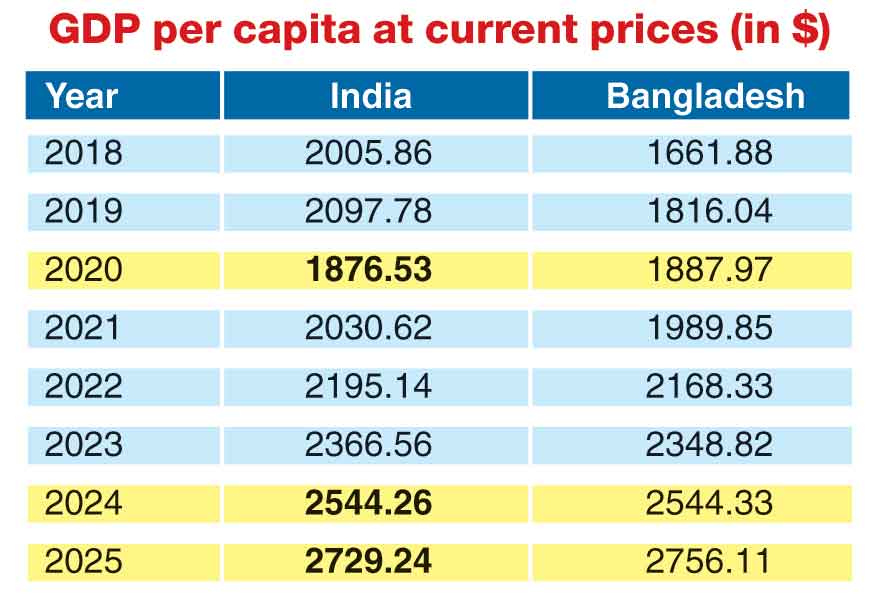Little else is requisite to carry a state to the highest degree of opulence from the lowest barbarism, but peace, easy taxes, and a tolerable administration of justice; all the rest being brought about by the natural course of things — Adam Smith
The words of the Father of Economics from the 18th century were confronting the 21st-century government in India on Wednesday after an IMF report began drawing attention across the country.
Quoting an IMF projection, Rahul Gandhi tweeted that Bangladesh was set to overtake India in 2020 in terms of per capita GDP — a measure of a country’s economic output per person.
“Solid achievement of 6 years of BJP’s hate-filled cultural nationalism: Bangladesh set to overtake India,” the Congress leader tweeted. By evening, it had been re-tweeted 11,500 times and had drawn over 34,000 likes.
Later in the day, Trinamul MP Abhishek Banerjee too posted a tweet on the same topic before questioning Prime Minister Narendra Modi’s “5 trillion (economy) dream”.
Going by the IMF report, released on Tuesday, India’s GDP is projected to shrink 10.3 per cent ending March 31, 2021, while that of Bangladesh is expected to grow 3.8 per cent.
In terms of absolute numbers, this means India’s per capita GDP is likely to be $1,877, the lowest in four years, while that of Bangladesh will be $1,888.
Although the comparison is not based on purchasing power parity, an economic term for measuring and comparing prices in different countries, Rahul’s tweet — accompanied by a graph that showed India was far ahead of Bangladesh on the same parameter in 1981 — made headlines both in India and Bangladesh.
(The IMF’s World Economic Outlook does give the GDP figures at current prices in PPP basis for both countries in its database. Bangladesh: $1.39 trillion in 2025 and India: $13.91 trillion.)

Source: World Economic Forum, IMF
“The IMF report doesn’t come as a surprise as Bangladesh has been growing steadily since 2009-10,” said Ashikur Rahman, senior economist, Policy Research Institute of Bangladesh.
Rahman said the Sheikh Hasina government’s success in bringing peace and stability, creating infrastructure and ensuring macroeconomic stability had helped Bangladesh achieve a steady growth path. “Our PM created the right environment for the country and it made all the difference. Today, our economy is resilient enough to absorb shocks,” the Bangladeshi economist said.
The changes brought about by Hasina spurred export growth and a steady increase in the rates of savings and investment in the past decade or so. Rahman said Dhaka’s foreign exchange reserve was more than $40 billion -- enough to pay for six months’ import bill.
In India, exports have fallen in recent years. Savings and investments, too, have declined. Although India is not worse off than the eastern neighbour on these two counts now, Bangladesh is projected to fare better than India in 2022 and 2023.
Instead of making news on its economic performance, India has made headlines for the rise in communal strife (which undermined peace), chaos over the system of taxation (which curbed business activities) and regular complaints about the absence of justice (which stymied individual enterprise).
The factors Smith had cited in An Inquiry into the Nature and Causes of the Wealth of Nations as catalysts for a country’s transition to a state of opulence are indeed missing in India.
According to IMF projections, India will be the third-poorest country in South Asia, after Pakistan and Nepal. Bangladesh, Bhutan, Sri Lanka and the Maldives are expected to be ahead of India.
Left economist Prasenjit Bose said the most important projection by the IMF World Economic Outlook is that India’s GDP will contract by 10.3 per cent in 2020, the sharpest fall among all emerging markets and developing economies.
“This is quite a fall from being the ‘fastest-growing major economy in the world’,” he said.
Comparing India’s per capita GDP with that of Bangladesh alone is somewhat arbitrary as South Asia as a whole continues to be among the world’s poorest regions, and the entire region is going to suffer a shock on account of the global recession, Bose said.
“Instead of looking at per capita GDP, we should also look at human development indicators like health outcomes and gender development index, on which Bangladesh has been doing better than India for quite a few years,” he said.












